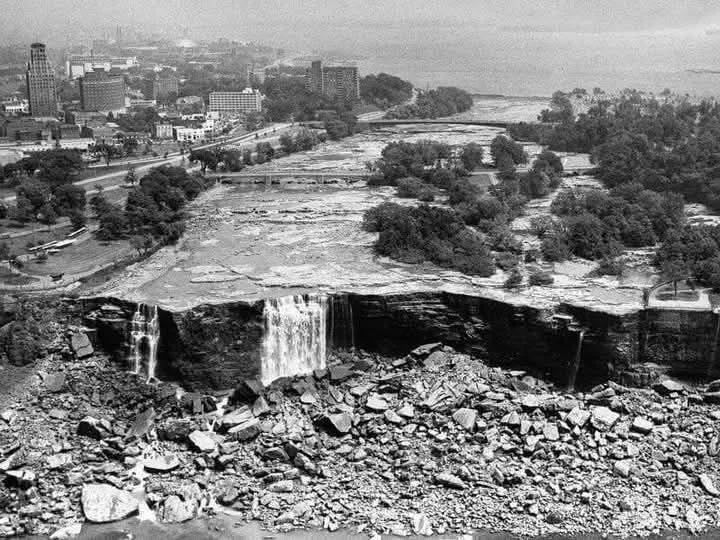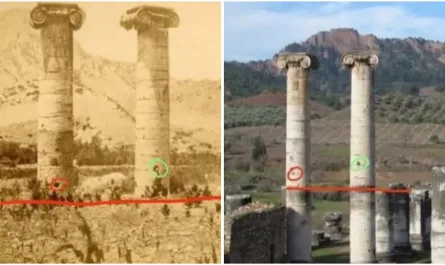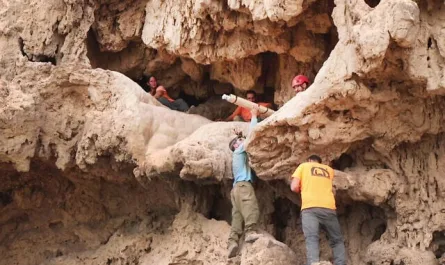In the summer of 1969, one of nature’s most iconic spectacles—Niagara Falls—was silenced. The American Falls, one of the three cascades that make up this world-famous landmark, was temporarily “turned off” in a daring engineering project. For several months, the roar of water was replaced by an eerie stillness, revealing the rocky secrets hidden at the base of the falls. This unprecedented operation, led by the U.S. Army Corps of Engineers, aimed to preserve the falls’ grandeur by addressing erosion and debris buildup. Let’s dive into this unique moment in history, exploring why and how it happened, and its lasting impact on Niagara Falls.

The Problem: Erosion and Debris Threaten the Falls
Niagara Falls, straddling the U.S.-Canada border, comprises three waterfalls: the American Falls, Bridal Veil Falls, and Horseshoe Falls. By the 1960s, concerns had grown about the stability of the American Falls. Over time, rocks and boulders dislodged by the relentless force of water had accumulated at the base, forming a talus slope. This debris not only diminished the falls’ dramatic 100-foot (30-meter) drop but also raised fears of further erosion that could destabilize the cliff face, potentially altering the falls’ appearance or even causing catastrophic collapse [1].
Public and scientific alarm peaked after a 1954 rockslide, when 185,000 tons of rock fell from the American Falls, reshaping its crestline [2]. Geologists worried that continued debris buildup could accelerate erosion, threatening the falls’ natural beauty and tourism appeal. In response, the U.S. Army Corps of Engineers, in collaboration with the International Joint Commission, launched a bold plan to temporarily stop the flow of water over the American Falls to study its geology and clear the debris.
The Plan: Turning Off the Falls
On June 12, 1969, engineers began the audacious task of diverting the Niagara River’s flow away from the American Falls. To achieve this, they constructed a temporary cofferdam—a barrier of 27,800 tons of rock and earth—upstream of the falls. This dam redirected the river’s flow toward the larger Horseshoe Falls on the Canadian side, effectively drying out the American Falls [3]. The sight was surreal: where millions of gallons of water once thundered, only a trickle remained, exposing the jagged limestone and shale bedrock beneath.
For the first time in thousands of years, the bare face of the American Falls was visible. Photographs from the time capture an otherworldly scene: a silent, dry cliff littered with boulders, some as large as houses, that had tumbled from the crest over centuries [4]. Tourists flocked to witness the spectacle, walking along the exposed riverbed where water once roared, a testament to human ingenuity and nature’s raw power.
The Work: Studying and Stabilizing the Falls
With the falls dry, engineers and geologists seized the opportunity to conduct a detailed survey. Their goals were twofold: assess the structural stability of the falls and determine whether removing the talus slope would preserve its longevity. Teams drilled into the bedrock to study its composition, installed monitoring equipment to detect future shifts, and mapped the extent of erosion [5]. The exposed rocks revealed a history of natural wear, with layers of dolomite and shale showing signs of fracturing under the water’s relentless force [6].
Initially, the plan included removing the massive boulders at the base to restore the falls’ full height and improve water flow. Workers used heavy machinery to clear some debris, but the scale of the task was daunting. Engineers soon realized that removing the entire talus slope could destabilize the falls further, as the rocks helped dissipate the water’s energy, reducing erosion at the base [7]. Instead, they opted for targeted interventions, including installing bolts and cables to anchor loose rock sections and prevent future slides [8].
The falls remained dry for nearly six months, from June to November 1969. During this time, the project drew global attention, with media outlets documenting the eerie sight of a waterless Niagara. Local businesses, initially worried about tourism losses, found that the novelty attracted curious visitors, eager to see a once-in-a-lifetime event [9].
The Outcome: Restoring the Flow
On November 25, 1969, the cofferdam was breached, and water surged back over the American Falls, restoring its majestic cascade. The roar returned, and the falls resumed their natural splendor, albeit with subtle changes. The decision to leave much of the talus in place preserved the falls’ stability while maintaining its iconic appearance [10]. The project also provided valuable data on the geology of Niagara Falls, informing future conservation efforts.
The 1969 operation remains a singular moment in the history of Niagara Falls. It demonstrated the delicate balance between human intervention and nature’s power, showing that even a force as mighty as the falls could be paused for study and preservation. The photographs of the dry falls—stark, silent, and strewn with rocks—remain a haunting reminder of this extraordinary endeavor.
Legacy and Lessons
The 1969 project underscored the importance of proactive conservation for natural wonders. The data collected helped engineers understand the ongoing erosion processes at Niagara Falls, which continues to recede at a rate of about 1 foot per year due to natural wear [11]. Subsequent efforts, such as regular monitoring and small-scale interventions, have built on this work to ensure the falls’ longevity.
The event also captured the public’s imagination, blending science, engineering, and spectacle. It showed that even iconic landmarks require care to maintain their grandeur for future generations. Today, Niagara Falls continues to draw millions of visitors, its thundering waters a symbol of nature’s beauty and resilience.
Have you ever visited Niagara Falls, or would you have braved the dry riverbed in 1969? Share your thoughts, and let’s marvel at this unique chapter in the falls’ storied history.
References
-
U.S. Army Corps of Engineers. (1970). Report on the American Falls Dewatering Project. Buffalo District Office.
-
Tesmer, I. H., & Bastedo, J. C. (1981). Geology of Niagara Falls. New York State Geological Association Guidebook, pp. 45–50.
-
Niagara Frontier State Park Commission. (1969). Niagara Falls Dewatering Summary. New York State Archives. 4మ
-
National Geographic. (1969). The Drying of Niagara Falls. August 1969 Issue.
-
Brett, J. R. (1972). Geological Survey of Niagara Falls. U.S. Geological Survey Report, 72(3), 201–210.
-
Goudie, A. S. (2004). Encyclopedia of Geomorphology. Routledge, pp. 335–340.
-
U.S. Army Corps of Engineers. (1969). Technical Report on American Falls Stabilization. Buffalo District.
-
Kostov, D. (2005). Niagara Falls: A Geological History. Geological Society of America, 37(4), 123–130.
-
Buffalo News. (1969). Niagara Falls Goes Dry: A Tourist Sensation. June 15, 1969.
-
Ibid.
-
Middleton, R. (2010). Erosion Rates of Niagara Falls. Journal of Great Lakes Research, 36(2), 69–75.





